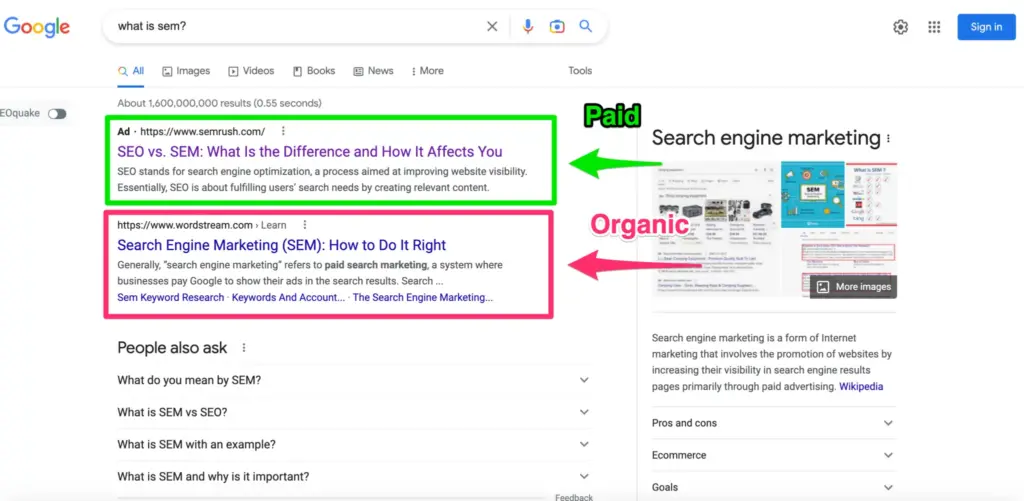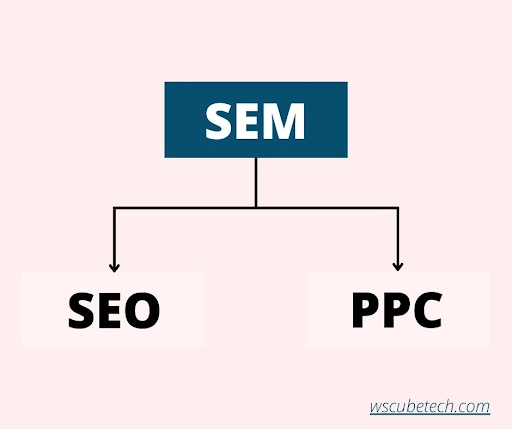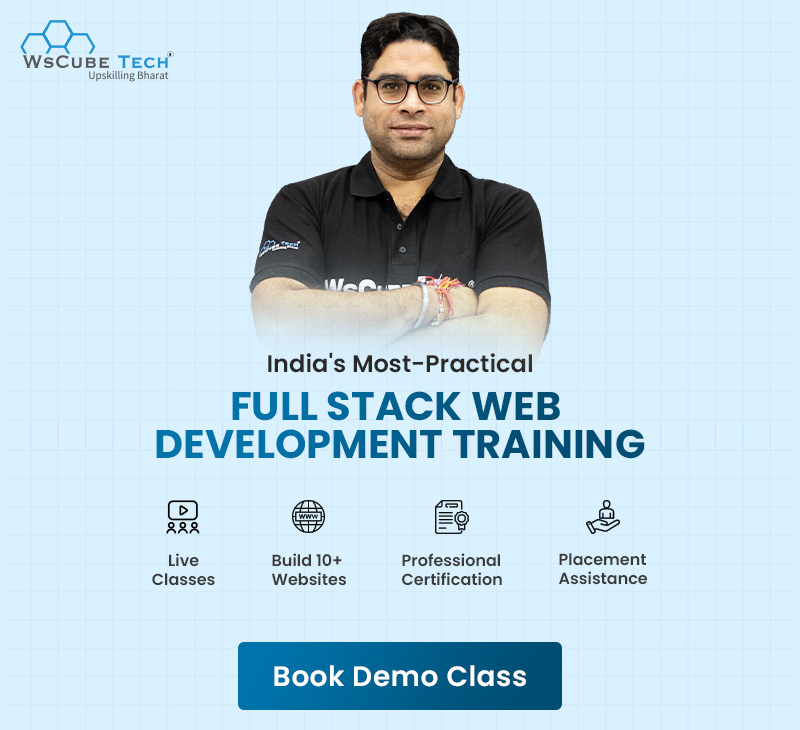Have you ever searched for “best restaurants near me” or “buy shoes online” and wondered how some websites always appear on top of Google? That’s not luck; it’s search engine marketing or SEM at work.
It’s the reason brands you know (and many you don’t) show up right when you’re looking for something.
But what is search engine marketing really?
In simple words, it’s using both paid ads (PPC) and organic optimization (SEO) to get your website visible on search engines and attract the right audience. This guide will help you understand SEM from scratch and how it helps businesses grow online.
What is Search Engine Marketing?
Search Engine Marketing, or SEM, is the process of promoting a website on search engines like Google or Bing to increase its visibility when people search for related products or services. It includes two main methods — Search Engine Optimization (SEO), which helps websites rank organically, and Pay-Per-Click (PPC) advertising, which displays paid ads above or below organic results.
So, SEM helps businesses appear in front of the right people at the right time, when they’re actively searching online. Whether it’s a blog post ranking through SEO or an ad running on Google, both are part of SEM’s goal: driving targeted traffic and boosting conversions.

How Search Engine Marketing Works?
1. You Search for Something Online
It all begins when you type a query like “best running shoes” on Google. The search engine instantly scans millions of pages to show the most relevant results: a mix of paid ads (PPC) and organic listings (SEO). This is where SEM comes into play.
2. Search Engines Display Paid and Organic Results
Once you hit search, Google shows two types of results — ads at the top and bottom (created through PPC campaigns) and organic results in between (earned through SEO). Together, they ensure users find exactly what they’re looking for, and brands get visibility.
3. Advertisers Bid for Keywords (PPC Part)
Businesses use platforms like Google Ads to bid on specific keywords their target audience searches for. When someone searches those keywords, Google runs an instant auction to decide which ads appear and in what order, based on the bid amount and ad quality.
4. Search Engine Optimization Improves Organic Ranking (SEO Part)
While PPC delivers instant results, SEO works gradually. We improve our website by using the right keywords, publishing helpful content, and building backlinks. Over time, this helps our pages rank higher in organic results, bringing long-term organic traffic without paying per click.
5. You Track, Analyze, and Optimize
The real power of SEM in digital marketing lies in tracking results. We analyze clicks, impressions, conversions, and costs using tools like Google Analytics and Ads Manager. Based on the data, we adjust keywords, ad copies, and landing pages to improve performance and ROI continuously.

Components of Search Engine Marketing (SEM)
Search Engine Marketing is made up of two main parts — Search Engine Optimization (SEO) and Pay-Per-Click Advertising (PPC). Both have the same goal: to increase visibility on search engines, but they work in different ways. Let’s understand the search engine marketing types easily.
1. Search Engine Optimization (SEO)
SEO is the process of improving your website so that it ranks higher in organic (non-paid) search results. When someone searches for a topic or product, Google shows pages that are most relevant and trustworthy. SEO helps your website become one of those top results.
To do this, we work on three areas:
- On-Page SEO: Using the right keywords, optimizing titles, headings, and images.
- Off-Page SEO: Building quality backlinks from other trusted websites.
- Technical SEO: Ensuring your website is fast, mobile-friendly, and easy for Google to understand.
Example: When you search “best laptops under ₹50,000,” the blogs ranking at the top without any “Ad” tag are there because of SEO.
2. Pay-Per-Click Advertising (PPC)
PPC is the paid side of SEM. Businesses pay search engines like Google to display their ads for specific keywords. You’ve probably noticed the small “Sponsored” or “Ad” label above some results — that’s PPC in action.
Below is how it works:
- You choose keywords you want your ads to appear for.
- You set a budget and bid for those keywords.
- You only pay when someone clicks your ad — hence, Pay Per Click.
PPC gives instant visibility and is great for quick results, product launches, or promotions, while SEO focuses on long-term organic growth.
Example: When you search “buy running shoes online” and see Amazon or Flipkart ads on top — that’s PPC.

SEO vs PPC in Search Engine Marketing
| SEO (Search Engine Optimization) | PPC (Pay-Per-Click Advertising) | |
| Type of Traffic | Organic | Paid (You pay per click) |
| Time to See Results | Slow and steady — takes weeks or months to rank | Instant — ads start showing as soon as campaign runs |
| Cost | No direct cost per click, but requires effort, time, and content investment | You pay every time someone clicks your ad |
| Duration of Results | Long-term — continues bringing traffic even after months | Short-term — stops when ad budget runs out |
| Goal | Build trust, authority, and consistent organic visibility | Drive quick traffic, leads, and conversions |
| Click-Through Rate (CTR) | Generally higher for top-ranked organic results | Can be high for highly targeted ads |
| Skill Focus | Content creation, keyword research, and optimization | Ad copywriting, bidding, and campaign management |
Benefits of Search Engine Marketing
The following are the SEM benefits:
1. Instant Visibility on Google
Unlike SEO, which takes time, SEM helps your website appear on top of search results almost instantly through paid ads. This quick visibility boosts brand awareness and allows new businesses to compete with established ones from day one.
2. Reaches High-Intent Audience
SEM targets people who are actively searching for products or services like yours. These users already have buying intent, so the chances of converting them into customers are much higher compared to other forms of marketing.
3. Measurable and Data-Driven
Every SEM campaign is trackable. You can see how many people viewed, clicked, or purchased through your ads. Tools like Google Ads and Analytics make it easy to measure success and refine strategies based on real performance data.
4. Cost-Effective and Flexible
SEM allows you to set your own budget, bid per keyword, and control ad spending. You can pause, adjust, or stop campaigns anytime. This flexibility makes it suitable for small businesses as well as large organizations.
5. Builds Brand Credibility
When your website appears consistently in both paid and organic search results, users start trusting your brand more. This dual visibility increases brand recognition and creates a professional image in your niche.
6. Faster Conversions and ROI
SEM targets ready-to-buy customers, leading to quicker conversions and better return on investment (ROI). By optimizing your ad copies and landing pages, you can turn clicks into sales efficiently.
7. Complements Other Marketing Efforts
SEM works perfectly alongside SEO, content, and social media marketing. It fills the gap while your organic reach grows and helps create a balanced, all-round digital presence for your business.
Read More Marketing Guides
Keyword Research – The Foundation of Search Engine Marketing
Keyword research is the starting point of every successful SEM strategy. It’s the process of finding the exact words and phrases people type into Google when searching for products, services, or information.
By knowing what your audience is searching for, you can target the right terms to make your ads and content more effective.
Why Keywords Matter:
In SEM, keywords decide when and where your ads or website appear. Choosing the right keywords ensures your business reaches people who actually want what you offer—making every click more valuable. Whether you’re doing SEO (organic) or PPC (paid), everything revolves around good keyword selection.
Types of Keywords:
| Keyword Type | Meaning | Example |
| Short-Tail Keywords | 1–2 words, broad and high in search volume but competitive. | “laptops”, “digital marketing” |
| Long-Tail Keywords | 3+ words, specific and less competitive but high intent. | “best laptops for students under ₹50,000” |
| Branded Keywords | Contain a company’s name. | “Nike shoes”, “Apple iPhone” |
| Transactional Keywords | Show strong buying intent. | “buy running shoes online”, “book hotel in Jaipur” |
| Informational Keywords | Used when people seek knowledge, not products. | “how to learn digital marketing”, “benefits of yoga” |
Key Metrics to Track in SEM
| Metric | Full Form / Meaning | Importance | Why It’s Important | Example |
| Impressions | Number of times your ad or page appears in search results. | Visibility — how often users see your ad. | Helps track brand exposure and reach. | Your ad appeared 10,000 times on Google. |
| Clicks | Total number of times users clicked your ad or link. | Engagement — how many people interacted. | Indicates interest and effectiveness of your ad. | 500 users clicked on your ad. |
| CTR (Click-Through Rate) | (Clicks ÷ Impressions) × 100 | Percentage of users who clicked after seeing your ad. | Shows how appealing your ad copy and keywords are. | 500 clicks ÷ 10,000 impressions = 5% CTR. |
| CPC (Cost Per Click) | Amount paid for each click on your ad. | Cost efficiency of your PPC campaign. | Helps manage ad spend and budgeting. | You spent ₹1,000 for 100 clicks = ₹10 CPC. |
| Quality Score | Google’s rating of your keyword relevance, ad quality, and landing page. | Relevance and overall user experience. | Higher score lowers CPC and improves ad rank. | Quality Score of 8/10 means your ad is highly relevant. |
| Conversion Rate | (Conversions ÷ Clicks) × 100 | How many clicks turned into desired actions (like sales or sign-ups). | Measures campaign success and ROI. | 50 sales from 500 clicks = 10% conversion rate. |
| CPA (Cost Per Acquisition) | Total cost ÷ number of conversions. | Cost to acquire one customer or lead. | Helps determine profitability of campaigns. | ₹5,000 spent for 50 sales = ₹100 CPA. |
| ROI (Return on Investment) | (Revenue – Cost) ÷ Cost × 100 | Profit earned compared to money spent. | Shows the financial success of your campaign. | You earned ₹10,000 from ₹5,000 spent → 100% ROI. |
| Bounce Rate | Percentage of visitors who leave your site without interaction. | Engagement and landing page quality. | High bounce rate means users didn’t find value. | If 60 of 100 users leave immediately, bounce rate = 60%. |
| Ad Rank | Determines position of your ad on search results. | Calculated using bid amount, Quality Score, and extensions. | Higher rank = better visibility. | Ad Rank 1 appears above Ad Rank 3 in Google results. |
Regularly monitor these SEM metrics using Google Ads, Google Analytics, and Search Console. Together, they help you identify what’s working, where to improve, and how to get the best results from your campaigns.
Best Tools for Search Engine Marketing
| Tool Name | Main Use | Description |
| Google Ads | PPC Campaigns | The most widely used platform for creating and managing paid search ads. It lets you bid on keywords, set budgets, and track ad performance directly on Google Search. |
| Google Keyword Planner | Keyword Research | A free tool within Google Ads that helps you discover keywords, check search volumes, and estimate ad costs — perfect for both SEO and PPC planning. |
| Google Analytics | Tracking & Analytics | Tracks how users interact with your website and ads. You can see where traffic comes from, which keywords convert, and how to improve performance. |
| SEMrush | SEO & PPC Analysis | An all-in-one marketing tool that helps with keyword research, competitor tracking, backlink audits, and ad insights. Great for understanding what’s working for your competitors. |
| Ahrefs | SEO Insights | Known for its powerful backlink database and keyword analysis. It helps improve rankings and understand how your site compares to others. |
| Ubersuggest | Keyword Research | A beginner-friendly keyword and SEO tool created by Neil Patel. It gives keyword ideas, content suggestions, and SEO metrics. |
| Moz | SEO Optimization | Offers keyword research, site audits, and rank tracking. Moz is great for beginners who want to improve their site’s visibility on Google. |
| SpyFu | Competitor Analysis | Lets you “spy” on competitors by showing what keywords they rank for and what ads they’re running, helping you plan better PPC and SEO campaigns. |
| Google Search Console | SEO Performance | A free tool that shows how your website performs in Google Search—tracking clicks, impressions, and technical issues that affect visibility. |
| ChatGPT (AI Tool) | Content & Ad Copy Creation | Helps generate keyword ideas, ad copies, blog outlines, and meta descriptions quickly. It’s a useful assistant for marketers to save time and boost creativity. |

Future of Search Engine Marketing
1. Rise of AI-Powered Search & Conversational Interfaces
Search is becoming less about typing keywords and more about asking questions. AI chatbots and generative engines like ChatGPT, Perplexity, Gemini, etc., are starting to act as “answer engines” — they don’t just return links, they generate concise answers.
This shift means SEM will need to optimize not just for pages but for being cited in AI responses.
2. Generative Engine Optimization (GEO) & Answer Engine Optimization (AEO)
As AI-based search grows, a new practice is emerging: GEO (Generative Engine Optimization). Instead of optimizing only for ranking in search results, marketers will also focus on getting their content selected by AI systems for direct answers. Likewise, AEO is about structuring content so it becomes the “answer” in AI outputs.
3. Decline of Click-Through Rates on Traditional SERPs
With AI overviews summarizing the answer on top, fewer users might feel the need to click through to websites. This will force brands to rethink how to make their content appealing enough to warrant clicks or how to get included in AI-generated summaries.
4. Search Fragmentation & Multiple Discovery Channels
Search won’t happen only on Google. People are beginning searches on YouTube, Amazon, TikTok, and inside AI tools. Each platform is becoming its own search engine. SEM strategies will need to adapt to multiple discovery paths.
5. AI-Driven Automation & Campaign Orchestration
Ad management, bidding, optimization — many of these tasks will increasingly be handled by AI and automation. Marketers will shift from executing tasks to guiding AI, defining strategy, and ensuring brand voice remains strong.
6. Emphasis on E-E-A-T, Authority & Brand Signals
As content gets evaluated by AI models, showing real-world experience, expertise, authoritativeness, and trustworthiness will become even more important.
Brand reputation, citations by other authoritative sources, and verified signals will boost visibility in both traditional and AI-powered search.
Career in Search Engine Marketing
Search Engine Marketing has become one of the most promising and in-demand careers in the digital world. As businesses depend more on online visibility and data-driven growth, the need for skilled professionals who can manage SEO (organic marketing) and PPC (paid advertising) has skyrocketed.
Whether you’re a student, freelancer, or working professional looking to upskill, a career in SEM offers excellent opportunities for creativity, analytics, and growth. Every company, from startups to large corporations, needs experts who can help them appear on Google, attract the right audience, and convert clicks into customers.
Why Choose SEM as a Career?
- High Demand Across Industries: Almost every business needs search visibility, regardless of its niche.
- Strong Earning Potential: Skilled SEM professionals earn competitive salaries, with bonuses tied to performance.
- Multiple Career Paths: You can specialize in SEO, PPC, analytics, or strategy based on your interests.
- Global Opportunities: SEM skills are universal and allow you to work with global clients or remotely.
Popular Job Roles in SEM
| Role | What You Do |
| SEO Executive / Specialist | Optimize websites to rank higher on Google using keywords, content, and backlinks. |
| PPC / Google Ads Specialist | Manage paid ad campaigns, set budgets, and improve ROI through bidding strategies. |
| SEM Analyst | Analyze campaign data, track performance, and improve targeting and ad copies. |
| Digital Marketing Manager | Plan and oversee all digital channels, including SEO, PPC, email, and social media. |
| Freelancer / Consultant | Help multiple clients improve their search visibility and ad performance. |
How to Start a Career in SEM?
- Learn the Basics: Start with free tutorials on YouTube (e.g., WsCube Tech).
- Get Certified: Earn certifications like Google Ads, Google Analytics, or HubSpot SEO.
- Get Mentorship from Industry Experts: To build a solid and high-paying career, you must go for digital marketing course by WsCube Tech that includes guidance from the industry’s top experts.
- Practice Hands-On: Create your own blog or Google Ads campaign to apply what you learn.
- Build a Portfolio: Show real examples of rankings or ad campaigns you’ve managed.
- Stay Updated: Follow industry blogs, Google updates, and AI trends shaping the future of SEM.

FAQs About Search Engine Marketing (SEM)
No. SEO is a part of SEM. SEO focuses on getting free, organic traffic through content and optimization, while SEM also includes paid advertising (PPC) to get faster visibility on search results.
SEM helps businesses reach potential customers at the right time — when they’re searching for something similar. It boosts brand awareness, drives traffic, and increases sales faster than most other marketing methods.
Both are important. SEO gives long-term results and builds trust, while PPC provides instant traffic and faster conversions. The best SEM strategies combine both for balanced growth.
Impressions show how many times your ad or website appeared in search results. High impressions mean strong visibility, but clicks matter more for performance.
Absolutely! SEM is ideal for small businesses. You can start with a low budget, target specific areas, and compete with bigger brands using smart keyword selection and optimized campaigns.
PPC ads show results immediately, while SEO can take 3–6 months to show significant improvement. The timeline depends on your competition, budget, and strategy.
Remarketing shows your ads to users who previously visited your website but didn’t take action. It helps remind them and encourages conversions later.
Yes. AI tools like ChatGPT, Jasper, and Google’s Smart Bidding help automate keyword research, write ad copies, and optimize bids — making SEM faster and smarter.
Explore Our Free Courses


